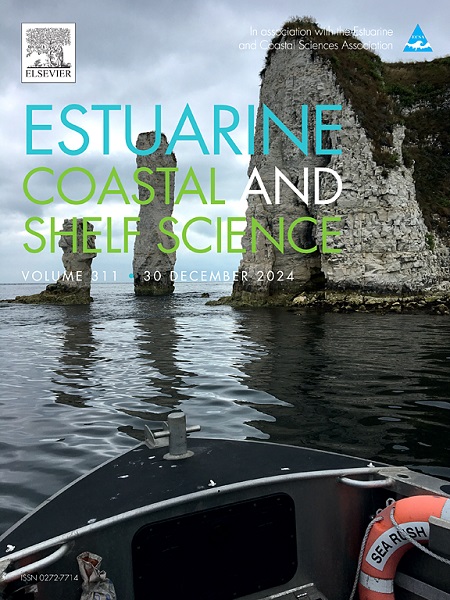Projected thermal stress and regional vulnerability of Manila clam production in Korean waters under climate change scenarios
IF 2.6
3区 地球科学
Q1 MARINE & FRESHWATER BIOLOGY
引用次数: 0
Abstract
The Manila clam (Ruditapes philippinarum) is one of the commercially valuable bivalves, but climate change poses a growing threat to its survival and production. This study analyzed projected changes in thermal stress conditions for Manila clams across seven coastal sites in the Korean Peninsula using CMIP6 model simulations under four SSP scenarios in years 2030, 2050, 2075, and 2100. We defined vulnerable conditions as sustained periods of eight or more consecutive days with water temperatures exceeding 26 °C, based on previous thermal threshold researches. Our analysis revealed distinct regional and temporal patterns in thermal stress vulnerability. Northern sites, particularly Wonsan Bay (39.18°N), showed relative stability until 2050 under moderate scenarios (SSP1-2.6, SSP2-4.5), while the most southern site, Geoje (34.76°N), exhibited the longest high temperature periods across all scenarios. Statistical analysis demonstrated significant temporal trends (p < .001) and regional differences (p < .001) in vulnerable days over all sites. The number of high-temperature days increased significantly from 2030 to 2075, with most pronounced changes during 2050–2075 (mean increase 16.14 days, p < .001) over all sites. The Yellow Sea sites showed greater absolute numbers of high-temperature days but less sensitivity to climate change compared to the East Sea sites, likely due to reduced influence from the Kuroshio Current. In consideration of the regional environmental impact of future climate change, we propose the adaptation strategies to support the sustainable production of clams including shifting the cultivation area to the northern region, developing heat-resistant species, adjusting farming calendars to avoid peak heat periods, and implementing deep-sea water cooling systems.
气候变化情景下韩国水域马尼拉蛤生产的预估热应力和区域脆弱性
马尼拉蛤(Ruditapes philippinarum)是一种具有商业价值的双壳类动物,但气候变化对其生存和生产构成了越来越大的威胁。本研究利用CMIP6模型模拟分析了在2030年、2050年、2075年和2100年四种SSP情景下,朝鲜半岛七个沿海地区马尼拉蛤的热应力条件的预测变化。根据之前的热阈值研究,我们将脆弱条件定义为水温超过26°C的连续8天或更长时间。我们的分析揭示了不同区域和时间的热应力脆弱性模式。在中等情景(SSP1-2.6和SSP2-4.5)下,北方样地元山湾(39.18°N)在2050年之前表现出相对稳定,而最南部的巨济(34.76°N)在所有情景中表现出最长的高温期。统计分析显示了显著的时间趋势(p <;.001)和地区差异(p <;.001)。2030 - 2075年高温日数显著增加,其中以2050-2075年变化最为显著(平均增加16.14天,p <;.001)。黄海地区的绝对高温天数比东海地区多,但对气候变化的敏感性较低,这可能是由于黑潮的影响较小。考虑到未来气候变化对区域环境的影响,我们提出了支持蛤蜊可持续生产的适应策略,包括将养殖区域转移到北部地区,开发耐热品种,调整养殖日历以避免高温高峰期,以及实施深海水冷却系统。
本文章由计算机程序翻译,如有差异,请以英文原文为准。
求助全文
约1分钟内获得全文
求助全文
来源期刊
CiteScore
5.60
自引率
7.10%
发文量
374
审稿时长
9 months
期刊介绍:
Estuarine, Coastal and Shelf Science is an international multidisciplinary journal devoted to the analysis of saline water phenomena ranging from the outer edge of the continental shelf to the upper limits of the tidal zone. The journal provides a unique forum, unifying the multidisciplinary approaches to the study of the oceanography of estuaries, coastal zones, and continental shelf seas. It features original research papers, review papers and short communications treating such disciplines as zoology, botany, geology, sedimentology, physical oceanography.

 求助内容:
求助内容: 应助结果提醒方式:
应助结果提醒方式:


